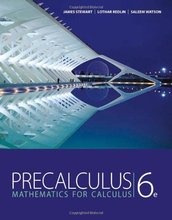Precalculus 6th Edition Blitzer Test Bank
$35.00 Original price was: $35.00.$26.50Current price is: $26.50.
Precalculus 6th Edition Blitzer Test Bank
Precalculus 6th Edition Blitzer Test Bank
Product details:
- ISBN-10 : 0134469143
- ISBN-13 : 978-0134469140
- Author: Bob Blitzer
With the new edition, Blitzer takes student engagement with the mathematical world to a whole new level drawing from applications across all fields as well as topics that are of interest to any college student (e.g., student loan debt, grade inflation, sleep hours of college students). Applications are also brought to life online in a new, assignable video series that explore the entertaining and mathematical Blitzer Bonus boxes. The new edition also aims to help more students to succeed in the course with just-in-time support in the text–such as Brief Review of prerequisite topics, Achieving Success boxes, and Retain the Concepts exercises–as well as support within MyLabTM Math such as new concept-level videos, assignable tools to enhance visualization, and more.
Table contents:
P. Prerequisites: Fundamental Concepts of Algebra
P.1 Algebraic Expressions, Mathematical Models, and Real Numbers
P.2 Exponents and Scientific Notation
P.3 Radicals and Rational Exponents
P.4 Polynomials
P.5 Factoring Polynomials
P.6 Rational Expressions
P.7 Equations
P.8 Modeling with Equations
P.9 Linear Inequalities and Absolute Value Inequalities
Summary, Review, and Test
Review Exercises
Chapter P Test
1. Functions and Graphs
1.1 Graphs and Graphing Utilities
1.2 Basics of Functions and Their Graphs
1.3 More on Functions and Their Graphs
1.4 Linear Functions and Slope
1.5 More on Slope
1.6 Transformations of Functions
1.7 Combinations of Functions; Composite Functions
1.8 Inverse Functions
1.9 Distance and Midpoint Formulas; Circles
1.10 Modeling with Functions
2. Polynomial and Rational Functions
2.1 Complex Numbers
2.2 Quadratic Functions
2.3 Polynomial Functions and Their Graphs
2.4 Dividing Polynomials; Remainder and Factor Theorems
2.5 Zeros of Polynomial Functions
2.6 Rational Functions and Their Graphs
2.7 Polynomial and Rational Inequalities
2.8 Modeling Using Variation
3. Exponential and Logarithmic Functions
3.1 Exponential Functions
3.2 Logarithmic Functions
3.3 Properties of Logarithms
3.4 Exponential and Logarithmic Equations
3.5 Exponential Growth and Decay; Modeling Data
4. Trigonometric Functions
4.1 Angles and Radian Measure
4.2 Trigonometric Functions: The Unit Circle
4.3 Right Triangle Trigonometry
4.4 Trigonometric Functions of Any Angle
4.5 Graphs of Sine and Cosine Functions
4.6 Graphs of Other Trigonometric Functions
4.7 Inverse Trigonometric Functions
4.8 Applications of Trigonometric Functions
5. Analytic Trigonometry
5.1 Verifying Trigonometric Identities
5.2 Sum and Difference Formulas
5.3 Double-Angle, Power-Reducing, and Half-Angle Formulas
5.4 Product-to-Sum and Sum-to-Product Formulas
5.5 Trigonometric Equations
6. Additional Topics in Trigonometry
6.1 The Law of Sines
6.2 The Law of Cosines
6.3 Polar Coordinates
6.4 Graphs of Polar Equations
6.5 Complex Numbers in Polar Form; DeMoivre’s Theorem
6.6 Vectors
6.7 The Dot Product
7. Systems of Equations and Inequalities
7.1 Systems of Linear Equations in Two Variables
7.2 Systems of Linear Equations in Three Variables
7.3 Partial Fractions
7.4 Systems of Nonlinear Equations in Two Variables
7.5 Systems of Inequalities
7.6 Linear Programming
8. Matrices and Determinants
8.1 Matrix Solutions to Linear Systems
8.2 Inconsistent and Dependent Systems and Their Applications
8.3 Matrix Operations and Their Applications
8.4 Multiplicative Inverses of Matrices and Matrix Equations
8.5 Determinants and Cramer’s Rule
9. Conic Sections and Analytic Geometry
9.1 The Ellipse
9.2 The Hyperbola
9.3 The Parabola
9.4 Rotation of Axes
9.5 Parametric Equations
9.6 Conic Sections in Polar Coordinates
10. Sequences, Induction, and Probability
10.1 Sequences and Summation Notation
10.2 Arithmetic Sequences
10.3 Geometric Sequences and Series
10.4 Mathematical Induction
10.5 The Binomial Theorem
10.6 Counting Principles, Permutations, and Combinations
10.7 Probability
11. Introduction to Calculus
11.1 Finding Limits Using Tables and Graphs
11.2 Finding Limits Using Properties of Limits
11.3 Limits and Continuity
11.4 Introduction to Derivatives
People also search:
blitzer precalculus 6th edition pdf answers
blitzer precalculus 6th edition solution manual pdf
You may also like…
Solution Manual
Algebra and Trigonometry 6th Edition Blitzer Solutions Manual
Solution Manual
Solution Manual
Solution Manual
Test Bank













